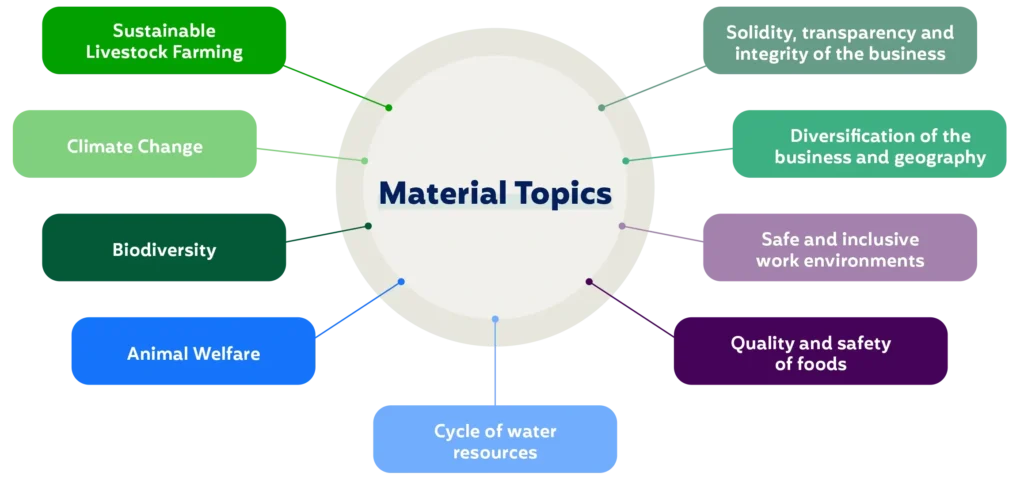Our approach to sustainability management focuses on six key themes that have been recognized as the most pertinent to Marfrig’s materiality matrix.
Marfrig’s Strategic Pillars
As one of the leading companies in animal protein, our operations are primarily guided by sustainability. We create value and conduct business for our stakeholders while adhering to guidelines and practices aimed at reducing our environmental impact, ensuring animal welfare is upheld whenever feasible, and conserving natural resources.

Strategic Directions in Sustainability
Sustainability-focused activities are integral to our everyday operations. To handle these initiatives more effectively, as well as to establish objectives and targets and monitor the outcomes, we have categorized these efforts into six strategic pillars.
1 – Origin Control: This area focuses on overseeing the source of raw materials and ensuring suppliers adhere to best sustainability practices. It also manages the implementation of the Verde+ Program, which aims to promote sustainable, low-emission livestock raising across the entire value chain. The culmination of this effort takes place at the industrial facility, where stringent quality and food safety measures are employed to monitor the use of antibiotics, hormones, and controversial chemicals that may be utilized in cattle rearing.
2 – Animal Welfare: This aspect oversees the treatment of animals, from farms to slaughterhouses, ensuring practices align with the recommendations from Compassion in World Farming and comply with the highest national and international humane slaughter standards.
3 – Climate Change: This initiative aims to achieve continuous improvements in processes to reduce the environmental impact of our operations related to climate change, while also adapting to evolving circumstances.
4 – Natural Resources: This focus advocates for the careful management of water and electricity usage in our production activities. Additionally, it aims to harness energy from clean, renewable sources.
5 – Wastewater and Waste: This area encourages environmentally responsible practices for the treatment of wastewater and solid waste generated by our operations.
6 – Social Accountability: This principle involves engaging suppliers in human rights-respecting practices, as well as fostering the development of new production methods, technologies, and initiatives that enhance inclusion, positively affecting the communities where we operate.
Significance
In the early part of 2023, the organization undertook a materiality assessment to reevaluate its priority areas concerning sustainability. This assessment, conducted with help from an external consulting firm, aimed to pinpoint issues and elements that would affect the company’s reporting cycle. The choice of topics was derived from an extensive evaluation of impacts, risks, business prospects, and alignment with Marfrig’s strategic goals and commitments. Additionally, they took industry trends, public interest, and international standards into account to inform their decision-making process.
The resulting Materiality Matrix now includes nine main themes, featuring the newly added biodiversity and business, along with geographic diversification. Some topics had their terminology adjusted and practices added, such as business stability, transparency, and integrity. Other topics, like sustainable livestock farming, climate change, the water resource cycle, and fostering safe and inclusive work environments, were revised and expanded to better represent ongoing efforts, measured impacts, and successes achieved. The aspects of animal welfare and food quality and safety were left unchanged. This thorough review and realignment of materiality factors illustrate the organization’s dedication to sustainability and its adaptability to emerging challenges and opportunities within the animal protein industry.

